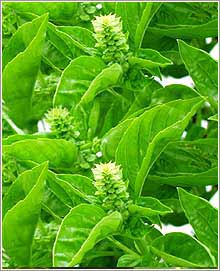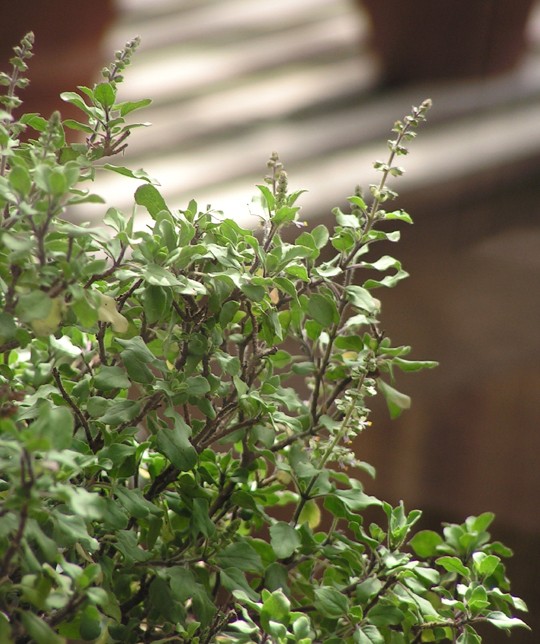Tulsi (Ocimum tenuiflorum)
[size=75]From Wikipedia, the free encyclopedia [/size]
Ocimum sanctum L.
Ocimum tenuiflorum (known as Holy basil in English, and Tulasi in Sanskrit), is a well known aromatic plant in the family Lamiaceae. Apart from its culinary uses, for which it is known across the world, it is also used as a medicinal plant, and has an important role within many traditions of Hinduism, wherein devotees perform worship involving Tulasi plants or leaves. Native to India, it is a short lived perennial herb or small shrub, often grown as an annual. The foliage is green or purple, strongly scented. Leaves have petioles, and are ovate, up to 5cm long, usually somewhat toothed. Flowers are white, tinged purple, borne in racemes.
Its aroma is distinctively different from its close cousin, the Thai Basil which is sometimes wrongly called Holy Basil, in shops and on the internet, but they can be distinguished by their aroma and flavour. Holy Basil is slightly hairy, whereas Thai Basil is smooth and hairless; Holy Basil does not have the strong aniseed or licorice smell of Thai Basil[1]; and Holy Basil has a spicy flavor sometimes compared to cloves.[2]
Known as Tulasi (alternate spelling Tulsi) in India it is an important symbol in many Hindu religious traditions which link the plant with the Goddess figure described in the Puranas. The name “Tulasi” in Sanskrit means “the incomparable one”[3]. The Tulasi plant is known in India in two forms - dark or Shyama (Krishna) Tulasi and light or Rama Tulasi. The former possesses greater medicinal value and is commonly used for worship.
Tulasi has also been known for thousands of years as a prime herb in Ayurvedic treatment, for its diverse healing properties. It is mentioned by Charaka in the Charaka Samhita, the central teaching of Ayurvedic medicine, and in the Rigveda. Tulasi is considered to be an adaptogen, balancing different processes in the body, and helpful for adapting to stress. [4] Marked by its strong aroma and astringent taste, it is regarded as a kind of “elixir of life” and believed to promote longevity.
Tulasi’s extracts are used in ayurvedic remedies for common colds, headaches, stomach disorders, inflammation, heart disease, various forms of poisoning, and malaria. Traditionally, tulasi is taken in many forms: as an herbal tea, dried powder, fresh leaf, or mixed with ghee. Essential oil extracted from Karpoora Tulsi is mostly used for medicinal purposes and in herbal toiletry. For centuries, the dried leaves of Tulasi have been mixed with stored grains to repel insects.
Recent studies suggest that Tulasi may be a COX-2 inhibitor, like many modern painkillers, due to its significant amount of eugenol (1-hydroxy-2-methoxy-4-allylbenzene).[5][6] Studies have also shown Tulsi to be effective for diabetes, by reducing blood glucose levels.[7] The same study showed significant reduction in total cholesterol levels with Tulsi. Another study showed that Tulsi’s beneficial effect on blood glucose levels is due to its antioxidant properties.[8]

